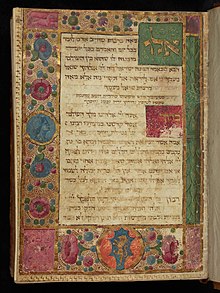This article needs additional citations for verification. (February 2024) |


The machzor (Hebrew: מחזור, plural machzorim, pronounced [maχˈzoʁ] and [maχzoˈʁim], respectively) is the prayer book which is used by Jews on the High Holy Days of Rosh Hashanah and Yom Kippur. Many Jews also make use of specialized machzorim on the three pilgrimage festivals of Passover, Shavuot, and Sukkot. The machzor is a specialized form of the siddur, which is generally intended for use in weekday and Shabbat services.
The word machzor means "cycle"; the root ח־ז־ר means "to return". The term machzor originally referred to a book containing prayers for the entire year, including weekdays and Shabbat as well as holidays. Later (first in Ashkenazi communities) a distinction developed between the siddur, which included weekday and Shabbat prayers, and the machzor, which included festival prayers.[2] Nevertheless, the original type of Machzor containing all of the prayers for the year continued to be used (even if less common) at least into the 20th century.[3]
- ^ "THE AMSTERDAM MAHZOR". THE AMSTERDAM MAHZOR.
- ^ "HebrewBooks.org Sefer Detail: מבוא למחזור בני רומא -- לוצטו, שמואל דוד בן חזקיה, 1800-1865". hebrewbooks.org..
- ^ See Machzor Kol Bo, Vilna 1923, Volume 1, Volume 2, Volume 3 and Volume 4.